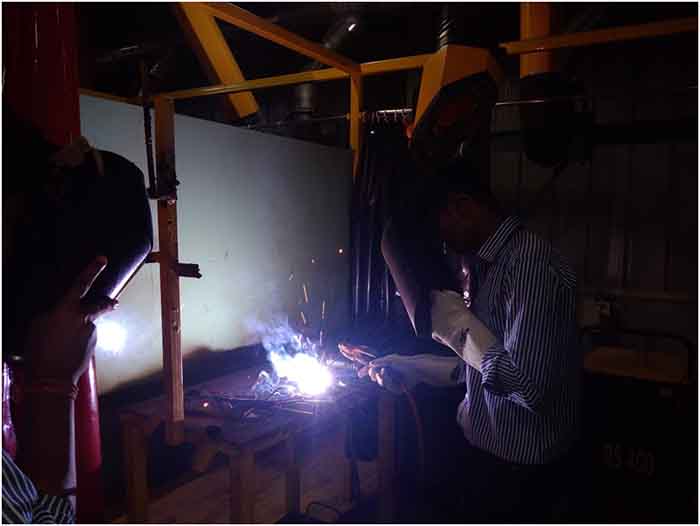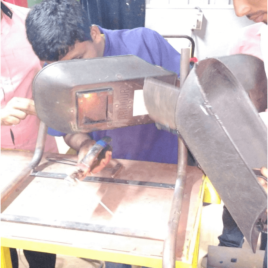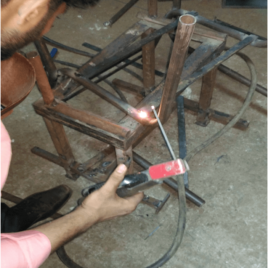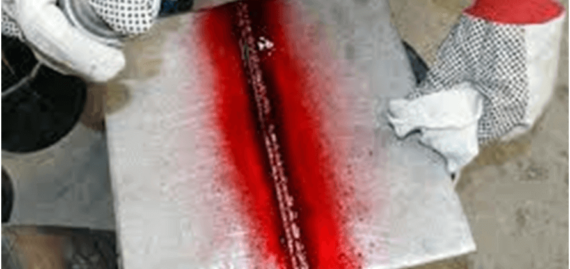Basic welding knowledge can enhance chances of employment. The industrial sectors like fabrication units, high pressure boilers manufacture, ship building, automobile, space engineering and cross-country pipelines require welding skill. Learning of quality and reliability criteria to be met by welded joints and standards will empower students for placement. More specifically, this domain will expose students on technological and institutional aspects of welding, both in theory and practice.
Welding and Inspection Domain
Domain Track: Welding and Inspection
Course Attendees
Still no participant
Course Reviews
Still no reviews
Track Total Credits (8-8-6) 22 total
Courses Division:
- Course 1: Joining Processes and Technology (2-2-2)
- Course 2: Metal Transfer and Weld Metallurgy (2-2-0)
- Course 3: Design of Welded Joints (Design and Validation, 3D Experience- CATIA) (2-2-2)
- Course 4: Testing of Welded Joints (DT, NDT and Microstructure) (2-2-2)
Domain Track Objectives:
- To develop understanding and skill of students for Welding Technology
- students pursuing this domain will be ready for industrial employment
- The students develop passion for higher education and research in Welding Engineering
Domain Track Learning Outcomes:
- Welding certification will make the candidate recognised in national and international levels in the industry
- He/she can be self-employed by opening a small scale welding shop to a medium scale industry
- Can produce Welding Design as per requirement using Dassault Welding Design module
- Suggest suitable Welds, based on Strength, Failure and Reliability
Career scope:
- ASNT Level II (LPI and UT) or NSQF skill certification will make the candidate recognised in national and international levels in the industry as qualified welding inspector.
- He/she can be self employed by opening a small-scale welding shop to a medium scaleindustry.
- Student has huge scope for conducting research work for presenting in international conference and publishing in journal, which can lift his career to greater heights.
Domain Syllabus:
1.Joining Processes and Technology (85 hrs)
- 1.1: Physics of arc welding
- 1.2: SMAW Principle and Equipment
- 1.3: Types of Electrodes, Functions of Coatings
- 1.4: TIG (GTAW), MIG (GMAW) & Flux-Cored Arc Welding
- 1.5: Submerged Arc Welding
- 1.6: Welding Positions, types of Joints
- 1.7: Residual Stress
- 1.8: Oxy-Acetylene Welding
- 1.9: Flux and Filler
- 1.10: Types of Gas Flames, Gas Welding Techniques
- 1.11: Difference between Gas Welding and Cutting Torch
- 1.12: Spot and Seam Welding Parameter, Projection Welding
- 1.13: Different types of Resistance Welding Electrodes
- 1.14: Newer welding processes-Flash Butt Welding, Friction Welding, Explosive Welding, Thermit welding of Rails, Electro-Slag Welding, Electro-Gas Welding, Stud Welding, Plasma Arc, Laser Beam, Electron Beam, Ultrasonic, Explosive Welding, Under Water Welding, High-Frequency Resistance and Induction Welding.
- 1.15: Electricity in Welding: Power Source and Equipment used for AC, DC Welding.
- 1.16: Selection of Filler Metals, Selection of a Welding Process, Procedures for Welding Stainless Steels.
- 1.17: AC Welding Machine Fundamentals, Shielding Gases (Purging), Filler Wire/Electrode Selection. Material Preparation, Weld Faults (Causes and Cures).
Practices:
- Experiment 1.1: Welding Safety Practice: Welding Fumes, Eye Protection, Personal Protective Equipment, Electrical Safety.
- Experiment 1.2: Brazing Practice: Types and Equipment required, Preparation of Joints for Brazing, Cleaning, making of two types of Brazed Parts- Cu and Brass, A/C Tubes.
- Experiment 1.3: Soldering Practice: Types of Solders, Equipment details, Preparation for Different Joints, making of two components through Soldering, viz. Electrical Elements, Electronics.
- Experiment 1.4: Gas welding Practice: Gas Welding Equipment- Torch, Gas Cylinder, Hose, Three Types of Flames, Welding of M.S. Sheet and Pipe by Gas Welding process.
- Experiment 1.5: Gas Cutting Practice: Oxy-acetylene cutting process Straight, Bevel & Circular Cutting on MS. Plate.
- Experiment 1.6: Shielded Metal Arc Welding–Manual Metal Arc Practice: Welding of M.S. Plate in all position by SMAW process, Repair & Maintenance works.
- Experiment 1.7: GTAW Welding Practice: GTAW Welding of M.S, SS & Aluminium Plate & Pipes.
- Experiment 1.8: GMAW Practice: Welding Torch, Electrode, Shielding Gas, GMAW Welding on M.S Sheet & M.S plate.
- Experiment 1.9: Resistance Welding Practice: Operating skills of SPOT Welding machine, Resistance Welding Machine Operation and Parameters.
- Experiment 1.10: AC, DC Welding, joint configuration and edge preparations familiarization for AC, DC Welding power source.
- Experiment 1.11: Identifying Defects and Remedial Measures for Welded Joints.
- Experiment 1.12: PUG Cutting Machine, SAW and PAW Demonstration.
- Experiment 1.13: Faults in welding and methods to solve them
- Experiment 1.14: Selection of Electrode and its effect
2. Metal Transfer and Weld Metallurgy (47 hrs)
- 2.1: Metal Transfer in AC and DC Arc Welding, Metal Transfer in TIG, MIG and MAG Welding
- 2.2: Study of different modes of Metal Transfer in MIG welding.
- 2.3: Theory and Principle of Process, Key Variables, Intermediate Materials.
- 2.4: Fe-C Equilibrium Diagram, Cooling Curve
- 2.5: HAZ, Microstructure
- 2.6: Pre Heat & Post Heat, Stress Relieving and Normalizing. Concept and significance
- 2.7: Percentage equivalence of Carbon in Weldability, Weldability of Carbon Steels.
- 2.8: Welding Defects due to improper Metal Transfer and improper Filler Material, Hot Cracks and Cold Cracks, Porosity, Embrittlement, Lamellar Tearing, Distortion etc.
- 2.9: Weldability of stainless steels, Weldability of Titanium and Alloys, Weldability of High Strength Low Alloy Steels.
- 2.10: Shot Pinning, Stress Reliving through Vibration.
- 2.11: Ultra-sonic Welding for Dissimilar Metals.
- 2.12: Stainless Steel-Types, properties of Stainless steels; Use in Industry,
- 2.13: Type of Welds and Weld Joints; Stainless Steels - Austenitic, Martensitic Ferritic Stainless Steels,
- 2.14: Sensitization, Hot Cracking, Precipitation Hardening Stainless Steels,
- 2.15: Duplex Stainless Steels, Physical Properties, Mechanical Properties.
- 2.16: Selection of a Stainless Steel, Design for Welding Stainless Steels,
- 2.17: Properties of Aluminum
- 2.18: GTAW (TIG) Theory Fundamentals on Aluminum, GTAW (TIG) Welding Techniques on Aluminum
- 2.19: SMAW Electrode for Aluminum.
- 2.20: Use of SMAW Electrode in Hard Facing
- 2.21: Flux Cored Wire Surfacing.
Practice:
- Experiment 2.1: Metal transfer in TIG welding
- Experiment 2.2: Different modes of Metal transfer in MIG welding
- Experiment 2.3: Welding defects in TIG welding
- Experiment 2.4: Welding defects in MIG welding
- Experiment 2.5: Practice on Stress Relieving and Normalizing in Welding
- Experiment 2.6: Experiments for demonstrating Weld-ability
- Experiment 2.7: Identification of general Welding Defects
- Experiment 2.8: Heat treatment of Welded Structures
- Experiment 2.9: Weldability of stainless steel
- Experiment 2.10: Practice for Hot Cracking
- Experiment 2.11: Faults in Welding and methods to solve them
- Experiment 2.12: Repair methods for Cast Iron Welded Parts
- Experiment 2.13: Surface Coating Procedure
3. Design of Welded Joints (Design and Validation, 3D Experience- CATIA)(38 hrs)
- 3.1: Introduction to Design
- 3.2: Engineering Properties of Steels
- 3.3: Type of Welds and Weld Joints.
- 3.4: Description of Welds: Terminology, Definitions and Weld Symbols;
- 3.5: Edge Preparation; Sizing of Welds in Structure.
- 3.6: Design for Static Loading,
- 3.7: Weld Calculations in Lap, Butt and Fillet Welds;
- 3.8: How to Design Various Kinds of Welding Joints.
- 3.9: Design of a Butt Joint, the main Failure Mechanism of Welded Butt Joint.
- 3.10: Design of Transverse Fillet Joint,
- 3.11: Shear Mechanism in Fillet Weld,
- 3.12: Design Stresses of Welds.
- 3.13: Use of CATIA Weld Design Module.
- 3.14: ASME & IBR Evaluation,
- 3.15: All Weld Tensile, Transverse Tensile, Bend Test 180° and 90°.
- 3.16: Evaluation of Test Plate (Practice).
Practice:
- Experiment 3.1: Design of Lap Joint
- Experiment 3.2: Design of Butt Joint
- Experiment 3.3: Tensile Testing of Welded Joints
- Experiment 3.4: Bend Test of Welded Joints
4. Testing of Welded Joints (DT, NDT and Microstructure) (40 hrs)
- 4.1: Weld Defects and NDT Welded Joints.
- 4.2: ASME Section IX
- 4.3: WPS and PQR
- 4.4: ASNT course for 3 days
Practice:
Destructive Tests:
- Experiment 4.1: Tensile test using Standard Equipment.
- Experiment 4.2: Impact test using Standard Equipment
- Experiment 4.3: Bend test using Standard Equipment
- Experiment 4.4: Hardness test using Standard Equipment
Non Destructive Tests:
- Experiment 4.5: Visual Inspection
- Experiment 4.6: Liquid Penetrant Test
- Experiment 4.7: Magnetic Particle Inspection
Microstructure:
- Experiment 4.8: Analysis of Microstructure by Image Analyzer
- Experiment 4.9: Analysis of Microstructure by SEM
5.PROJECT: 6credits
6.INTERNSHIP:4 credits
Session Plan for the Entire Domain:
1: Joining Processes and Technology 85 hours
- Session 1:WeldingSafety
- PDF...

- Session 2:Personal safety and welding safety
- Video...

- Session 3:Intro to Welding Technology
- PDF...

- Session 4:Welding, Brazing, Soldering
- PDF...

- Session 5:Soldering And Brazing (Difference)
- Video...

- Session 6:Intro to Oxy-Acetylene Welding
- Video...

- Session 7:What is STICK Welding? (SMAW)
- Video...

- Session 8:Introduction to Resistance Welding
- Video...

2: Metal Transfer and Weld Metallurgy 47 hours
- Session 1:Laser Welding
- PDF...

- Session 2:Modes of Metal Transfer | Short Circuit vs Spray vs Globular
- Video...

- Session 3:Welding defects|| Animation || 7 different types of defect
- Video...

- Session 4:Heat treatment of metals | Types. Process, Applications
- Video...

- Session 5:What is WELDABILITY?
- Video...

3: Design of Welded Joints (Design and Validation, 3D Experience- CATIA) 38 hours
- Session 1:design of welding
- PDF...

- Session 2:catia single u-butt joint weld
- Video...

- Session 3:Weld Design, CATIA
- Video...

- Session 4:Welding Analysis in CATIA
- Video...

- Session 5:Tutorial Catia Welding Analysis of Component
- Video...

- Session 6:catia FEA seam weld
- Video...

4: Testing of Welded Joints (DT, NDT and Microstructure) 40 hours
- Session 1:welding defects, causes and correction
- PDF...

- Session 2:Welding Defects
- PDF...

- Session 3:Mechanical Testing - Bend tests
- Video...

- Session 4:Tensile Test on ASME Welded Sample
- Video...

- Session 5:Mechanical Testing-charpy impact test
- Video...

- Session 6:Hardness testing- Welding inspector-Welding inspection
- Session 7:Visual Weld Inspection
- Video...

- Session 8:Liquid Penetrant Testing (Non Destructive Testing)
- Video...

- Session 9:Magnetic Particle Testing
- Video...

List of Projects/ papers/jobs/products to be done in domain:
- Box Jig (Design and Manufacturing)
- Fixture for MIG Gun (Design and Manufacturing)
- Ergonomically designed welding table with compartment for power source and tools tray (Design and Manufacturing)
- Welding slag cleaning machine (Design and Manufacturing)
- 5. Ergonomically designed motorised wheelchair (Design and Manufacturing)
Gate Process for Project
- Gate 0: Idea
- Gate 1: Scope
- Gate 2: Development
- Gate 3: Testing
- Gate 4: Documentation
Latest News & Student Testimonials
Media

Our Main Teachers

Sudeep Kumar Singh is currently a Ph.D. Research Scholar in Department of Mechanical Engineering CUTM Odisha, India. He received his Diploma in Mechanical Engg. From JES Jharsuguda, B.Tech degree in Manufacturing Science & Engg., from UCE Burla, M.Tech in CAD/CAM from BPUT Odisha. He has worked for 5 years in the industry, 10 years as […]
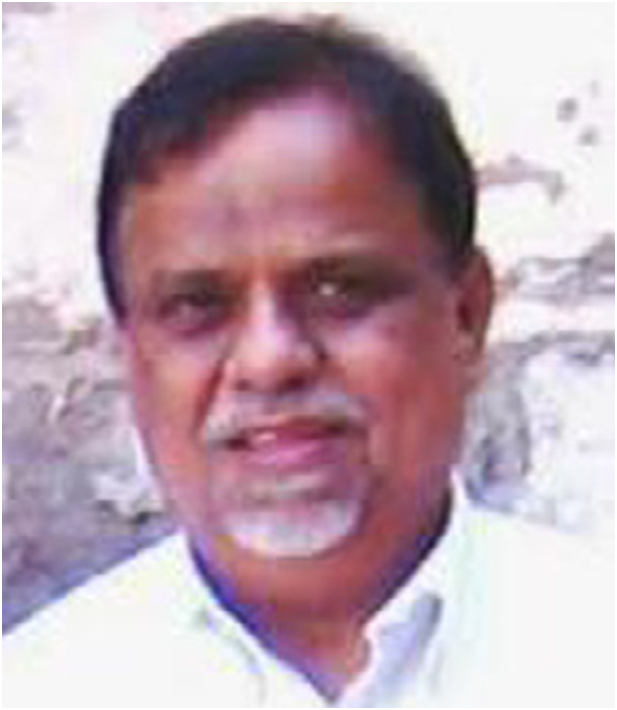
Dr. ArdhenduMouli Mohanty has an experience of 45 years, 35 years in the industry and 10 years in academics. A graduate in Mechanical Engineering from University College of Engineering, Sambalpur University in the year 1973. He obtained M.Tech in Production Science & Technology from IIT Kharagpur and PhD in Welding Engineering from IIT Madras. JoinedBHEL […]

